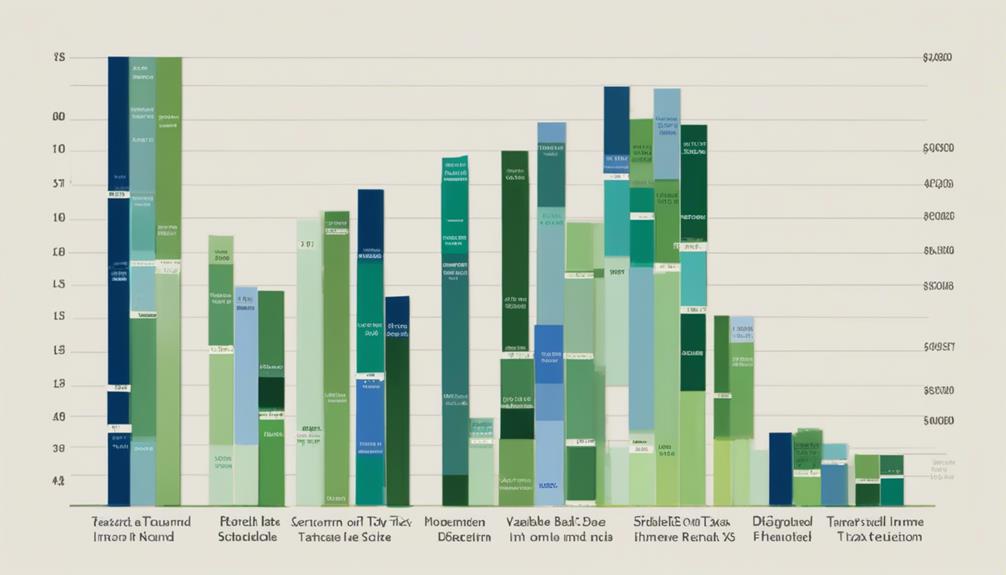As a California resident, you know that traversing the state's complex income tax system is essential for maximizing your refund. Understanding how tax brackets impact your liability can mean the difference between a modest return and a substantial one. By strategically managing your income and deductions, you may be able to lower your overall tax burden and keep more of your hard-earned money. Exploring these nuances could uncover valuable opportunities to optimize your filing and boost your refund. Delving into the details may just hold the key to accessing a more favorable outcome when tax season arrives.
Key Takeaways
- Understanding California's tax brackets, ranging from 1% to 13.3%, is crucial for minimizing tax liability and maximizing refund.
- Leveraging deductions like mortgage interest, charitable contributions, and the standard deduction can significantly reduce taxable income and increase refunds.
- Strategically planning around income thresholds and marginal tax rates can help optimize refund calculations and minimize tax burdens.
- Accurately calculating taxable income by claiming eligible deductions is essential for determining the appropriate tax bracket and refund amount.
- Adjusting withholding throughout the year to align with expected tax liability can help avoid overpayment and ensure a larger refund.
Understanding California Income Tax Brackets

As a resident of California, understanding the state's income tax brackets is essential for managing your financial obligations effectively. The nuances of these tax brackets can have a significant impact on your overall tax liability. Unlike federal income tax, which follows a standardized set of brackets, California's state tax variations require a more tailored approach.
Each tax bracket in California corresponds to a specific range of taxable income, and the rate applied to that income can range from 1% to 13.3%, depending on your total earnings. This means that the more you earn, the higher the percentage of your income that will be subject to state taxes. Maneuvering these brackets and comprehending how they affect your specific financial situation is pivotal for maximizing your tax refund and ensuring you're paying the appropriate amount.
How Tax Brackets Affect Refunds
Your tax bracket determines how much you'll owe in California state income taxes. Deductions can reduce your taxable income and lower your tax liability. Understanding how your income thresholds and marginal tax rates affect your potential refund can help you plan your finances more effectively.
Understanding Marginal Tax Rates
Understanding how marginal tax rates work is crucial for precisely calculating your tax refund. In California, the state income tax system uses a progressive tax rate structure, where your income is taxed at different rates depending on the tax bracket it falls into. This means that as your income increases, the percentage of taxes you pay on each additional dollar will also rise.
Your effective tax rate, which is the overall percentage of your income that you pay in taxes, is not the same as your marginal tax rate, which is the rate applied to the last dollar you earned. It's important to take into account both when estimating your refund. By understanding how marginal tax rates work, you can better plan your finances and maximize your California tax refund by taking advantage of all available deductions and credits.
Income Thresholds and Refunds
With your California taxable income in mind, the specific tax bracket you fall into will directly impact your refund amount. Effective tax planning involves optimizing your income thresholds to maximize your potential refund. If your taxable income falls near the top of a lower tax bracket, you may be able to make strategic deductions or adjustments to slide into a lower bracket, ultimately boosting your refund. Conversely, if your income is just below a higher bracket, you could consider shifting some income to the following year to take advantage of the higher thresholds and potentially claim a larger refund. Understanding the nuances of California's tax brackets is fundamental for optimizing your income thresholds and ensuring you receive the maximum refund you're entitled to. By leveraging this knowledge, you can navigate the tax landscape confidently and keep more of your hard-earned money in your pocket.
Deductions and Tax Liabilities
California's tax brackets don't just determine your tax liability – they also play a critical role in your potential refund. The deductions you claim can drastically impact your overall tax bill, so it's crucial to understand how they interact with your tax bracket.
The mortgage interest deduction, for example, can be a powerful way to reduce your taxable income. The higher your tax bracket, the more valuable this deduction becomes. Similarly, the charitable contributions deduction allows you to offset your income and potentially qualify for a lower bracket. By strategically timing your deductions, you can minimize your tax liability and maximize your refund.
Calculating Taxable Income in California

To calculate your taxable income in California, you'll need to determine your total income and then subtract any applicable deductions. The standard deduction can substantially reduce your taxable income, while itemized deductions like mortgage interest and charitable contributions may provide even greater savings. Understand how these deductions affect your final tax liability and refund amount.
Taxable Income Determination
Determining your taxable income in California is the essential first step in calculating your state income tax liability. To arrive at your taxable income, you'll need to start with your gross income and make a series of adjustments:
- Include all sources of income, such as wages, salaries, tips, interest, dividends, and capital gains.
- Identify and claim eligible deductions, such as mortgage interest, charitable contributions, and health savings account contributions.
- Apply any applicable credits, such as the California Earned Income Tax Credit or the Child and Dependent Care Credit.
- Determine your filing status, which can impact the tax rates and deductions you're eligible for.
- Verify you've accurately calculated your taxable income, as this figure directly determines the amount of state income tax you owe.
Standard Deduction Impact
After you've determined your gross income and claimed eligible deductions, the next step is to ponder the impact of the standard deduction on your taxable income in California. The standard deduction amount can substantially reduce your taxable income, resulting in a lower tax liability. For the 2023 tax year, the standard deduction in California is $8,800 for single filers and $17,600 for married couples filing jointly.
To be eligible for the standard deduction, you'll need to forgo itemizing your deductions. This means you won't be able to claim specific expenses like mortgage interest, charitable contributions, or state and local taxes. However, if your standard deduction exceeds the total of your itemized deductions, it's generally more advantageous to claim the standard deduction. Carefully review your situation to determine the approach that maximizes your refund.
Itemized Deductions Effect
If you choose to itemize your deductions rather than take the standard deduction, you'll need to calculate your total eligible itemized deductions. This can make a significant difference in your taxable income and the amount of California income tax you owe.
When itemizing deductions, you'll need to examine the following:
- Charitable contributions: Donations to qualified charitable organizations are generally tax-deductible, so be sure to keep track of your charitable giving throughout the year.
- Mortgage interest deductions: You can deduct the interest paid on up to $1 million of mortgage debt for your primary residence and second home.
- State and local taxes: You can deduct up to $10,000 in state and local taxes, including property taxes and either income taxes or sales taxes.
- Medical expenses: You can deduct the portion of your medical expenses that exceed 7.5% of your adjusted gross income.
- Miscellaneous deductions: Other eligible expenses, such as unreimbursed employee expenses, may also be deductible.
Carefully reviewing your itemized deductions can help you maximize your refund and minimize your California income tax liability.
Deductions and Their Impact on Taxes
Deductions can greatly impact your California income tax liability, potentially reducing the amount you owe. Charitable contributions, for instance, can be deducted from your taxable income, lowering your overall tax burden. Similarly, self-employment deductions, such as those for business expenses, can also substantially reduce your taxable income.
It's essential to carefully track and document all eligible deductions to maximize your refund. Keep meticulous records of your charitable donations, medical expenses, and any other deductible items. Additionally, be mindful of any changes in tax laws or regulations that may affect the deductions you can claim.
Filing Status and Its Importance

Your filing status is an essential factor in determining your California income tax liability. It defines your eligibility for various deductions, credits, and tax rates. Choosing the right filing status can noticeably impact the amount of taxes you owe or the size of your refund.
- Married Filing Jointly: This status allows you and your spouse to combine your incomes and claim the maximum deductions and credits. It's often the most advantageous option for couples.
- Head of Household: If you're unmarried and support a qualifying dependent, this status may provide you with a higher standard deduction and lower tax rates.
- Single: This is the default filing status for individuals who are not married, widowed, or the head of a household.
- Married Filing Separately: While this status may limit your eligibility for certain tax benefits, it can be useful in specific situations, such as when spouses have vastly different incomes.
- Qualifying Widow(er): This status is available for those who have lost a spouse and have a dependent child.
Understanding your filing status and optimizing it based on your taxpayer eligibility criteria can help you maximize your California income tax refund.
Special Considerations for High-Income Earners
For high-income earners in California, special tax considerations come into play. The state's progressive tax rates mean you'll pay a higher percentage on your top-tier income. This can profoundly affect your overall tax liability, so it's vital to understand how these brackets impact your situation.
Additionally, capital gains considerations are essential. If you've realized substantial investment profits, you'll need to account for the tax implications. Careful planning can help guarantee you're not caught off-guard by unexpected capital gains taxes.
Strategies for Minimizing Tax Liability

Savvy Californians can leverage deductions and credits to minimize their tax liability. Additionally, adjusting your withholding strategies can help manage your cash flow and avoid underpayment penalties. Explore these options to keep more of your hard-earned money.
Deductions and Credits
When it comes to minimizing your tax liability in California, leveraging available deductions and credits can make a significant difference. From charitable contributions to medical expenses, there are a variety of ways you can lower your taxable income and maximize your refund.
- Consider itemizing your deductions if they exceed the standard deduction. This can include deductions for mortgage interest, property taxes, and charitable donations.
- Take advantage of the California Earned Income Tax Credit (CalEITC) if you're a low-to-moderate-income earner. This refundable credit can put more money back in your pocket.
- Explore deductions for qualified medical expenses that exceed 7.5% of your adjusted gross income. This can include costs for healthcare, prescription medications, and even mileage for medical-related travel.
- Claim the Child Tax Credit for each qualifying child, which can reduce your tax bill dollar-for-dollar.
- Take the California Renter's Credit if you paid rent during the tax year, even if you don't itemize deductions.
Withholding Strategies
Alongside leveraging deductions and credits, carefully managing your withholding can markedly lower your California tax liability. Paycheck adjustments are a powerful tool to optimize your withholding. Review your W-4 form and consider making withholding adjustments to match your expected annual income and deductions. This can help you avoid overpaying throughout the year and receiving a smaller refund, or worse, unexpectedly owing taxes. Strategically adjusting your withholding can put more of your hard-earned money in your pocket each month. Additionally, review your withholding periodically, as life changes like a new job, marriage, or having a child can noticeably impact your tax situation. Stay vigilant and make timely withholding adjustments to keep your California tax payments aligned with your liability. Mastering withholding strategies is key to maximizing your refund and minimizing your overall tax burden.
The Role of Withholding in Refunds
Withholding plays a pivotal role in determining the size of your tax refund. Your withholding amount, based on your payroll deductions and withholding calculations, directly impacts the difference between the taxes you've paid throughout the year and your actual tax liability.
- Accurate withholding can help you avoid owing a large sum during tax season, but it can also mean a smaller refund.
- Excessive withholding, on the other hand, may result in a larger refund, but it also means you've effectively provided the government with an interest-free loan throughout the year.
- Striking the right balance between withholding and your actual tax liability is key to maximizing your refund.
- Adjusting your withholding allowances can help you fine-tune the amount withheld from your paycheck, potentially leading to a more suitable refund.
- Regularly reviewing your withholding and making necessary adjustments can help guarantee you're not over-or under-paying your taxes throughout the year.
Preparing for California Tax Season

As you prepare for California's tax season, it's crucial to familiarize yourself with the state's income tax brackets. These brackets determine the percentage of your income that you'll owe in state taxes, so understanding them is key to effective tax planning.
First and foremost, make sure you have all the necessary records to file your taxes accurately. This includes pay stubs, 1099 forms, and any other documentation related to your income and deductions. Proper recordkeeping is indispensable to ensuring you claim all the credits and deductions you're entitled to, maximizing your refund.
Additionally, consider your tax planning considerations. Are there any strategies you can implement, such as contributing to a retirement account or taking advantage of deductions, to lower your taxable income and move into a lower tax bracket? Careful planning can make a significant difference in the amount you owe or the refund you receive.
Consulting Tax Professionals for Guidance
Consulting a tax professional can provide invaluable guidance when maneuvering California's income tax system. These experts possess the knowledge and expertise to guarantee you maximize your refund and minimize your tax liability.
- Identifying relevant deductions and credits: A tax professional can help you uncover potential deductions and credits you may have overlooked, ensuring you pay the smallest amount of taxes legally possible.
- Confirming compliance with complex regulations: The California tax code is notoriously intricate. A tax professional can guide you through the maze of rules and regulations, helping you avoid costly mistakes.
- Offering personalized strategies: Every taxpayer's situation is unique. A tax professional can develop tailored strategies to optimize your tax planning and minimize your overall tax burden.
- Representing you in the event of an audit: Should you face an audit, a tax professional can serve as your advocate, protecting your interests and guiding you through the process.
- Staying up-to-date with changes: Tax laws and regulations are constantly evolving. A tax professional can confirm you're informed about any changes that may impact your tax situation.
